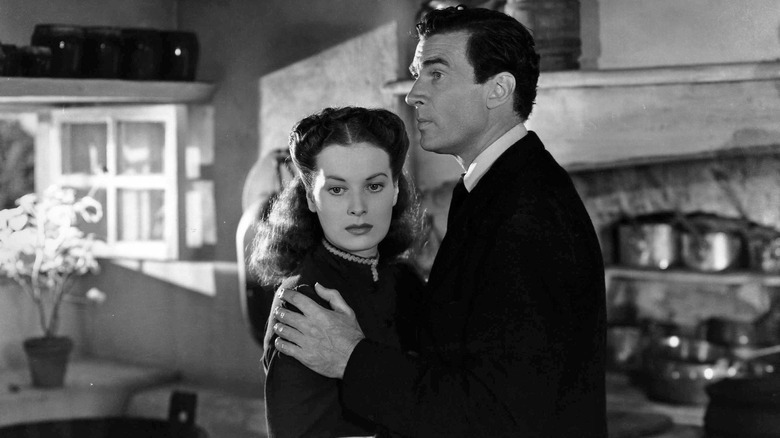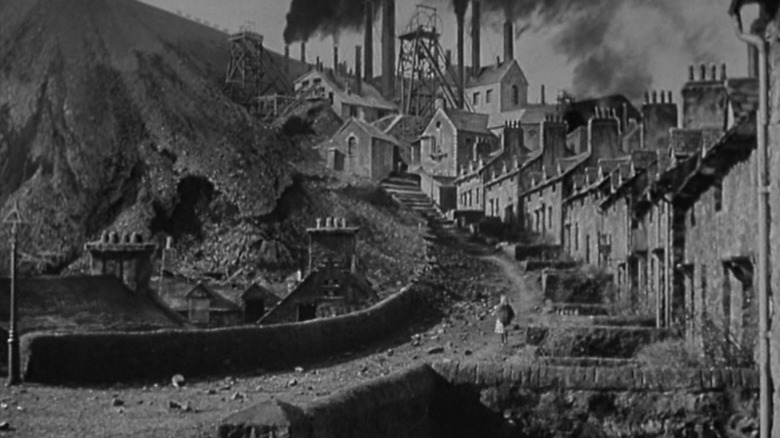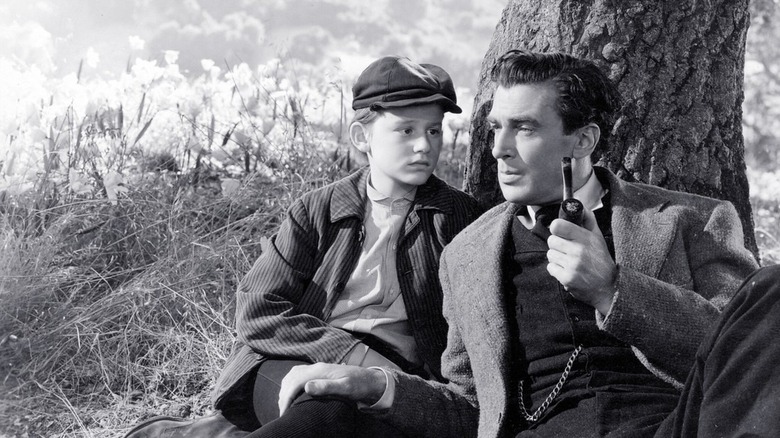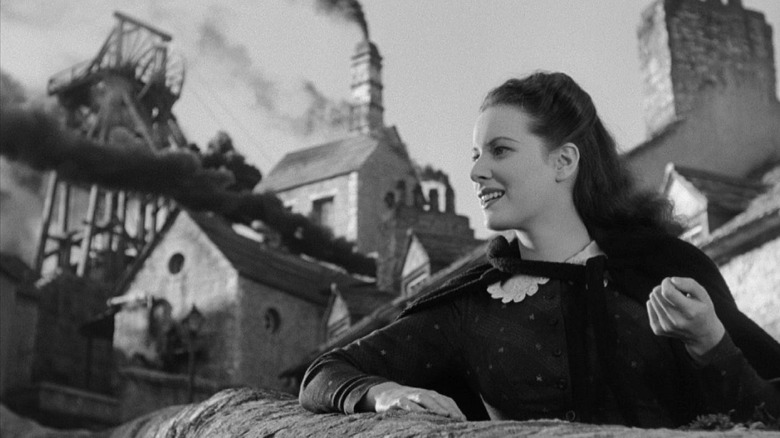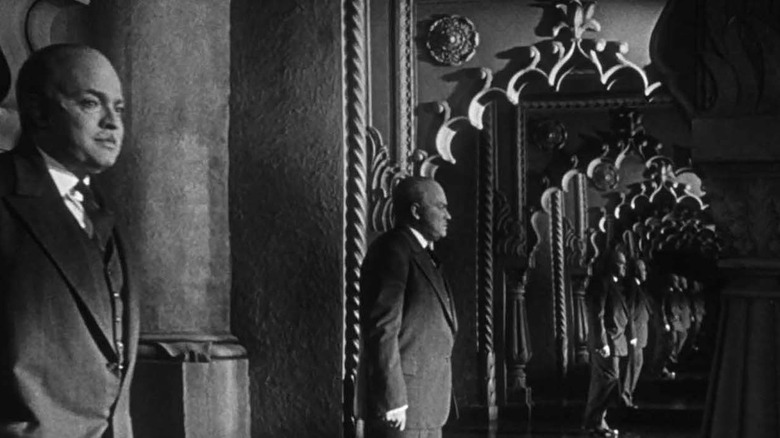The 1941 Drama That Won Fox Its First Ever Best Picture Oscar
The studio once known as 20th Century Fox is a younger entity than the other major Hollywood Studios. It was founded in 1935 out of the ashes of Fox Film, compared to Warner Bros (1923), Universal Pictures (1912), Paramount Pictures (1912), Columbia Pictures (1923), and Disney (1923) — the latter being the new parent company of 20th Century Studios.
Still, Fox waited only seven years to take home the top prize at the Oscars. At the 14th Academy Awards, held in 1942, Fox's film "How Green Was My Valley" won Best Picture, presented to Fox studio chief Darryl F. Zanuck. That wasn't the only prize "Valley" won that night: it also got Best Director (John Ford), Best Supporting Actor (Donald Crisp), Best Cinematography, Black-and-White (Arthur Miller), and finally Best Art Direction — Interior Decoration, Black-and-White (Richard Day, Nathan H. Juran, and Thomas Little).
One of the films that "Valley" beat that night was "Citizen Kane" (which got only Best Original Screenplay for director Orson Welles and his co-writer Herman J. "Mank" Mankiewicz). Proving that history decides its own winners, "Citizen Kane" is now shorthand for "Best Movie Ever" while "Valley" is the also-ran despite being the actual winner; the general understanding is that its winning over "Kane" was unearned.
"Valley" is not as well-remembered as some of Ford's pictures like "Stagecoach," "The Searchers," or "The Man Who Shot Liberty Valance," either. So why did it go home well-heeled on the night of February 26, 1942, and then fall in grace while a film it defeated rose?
How Green Was My Valley
"How Green Was My Valley" adapted the 1939 novel of the same name by Richard Llewellyn; both book and film focus on the hard times of a Welsh coal mining village in the late 1800s/early 1900s. Narrator Huw Morgan (Irving Pichel) chronicles the events of his childhood, and his family's tragedies, with rose-tinted glasses. (Hew's child self is played by future "Planet of the Apes" star Roddy McDowall.)
"20th Century-Fox: Darryl F. Zanuck and the Creation of the Modern Film Studio" (a book written by Hollywood historian Scott Eyman) says that in Fox's early years, Zanuck focused the studio's output on three tentpole genres: historical epics, musicals, and family dramas. "How Green Was My Valley" was in the third category. (Eyman says it hits the same beats as Ford's 1940 "The Grapes of Wrath," only moved from the American West to Wales.) So much so that the film cuts out portions of the novel to narrow the focus on the Morgan family.
As Eyman recounts, Zanuck ordered revisions to the first draft by Ernest Pascal. This draft was more political and "revolutionary," emphasizing the labor struggles between the Welsh miners and their bosses, but Zanuck felt the conflict was too far removed from audiences for them to "give a damn." When the final film touches on such subjects, it is not to rouse the audience with pro-labor messages. No, "How Green Was My Valley" uses the struggles of the working man to tug at the heartstrings. The film shows how a strike causes resentment in the village, how the Morgan family is briefly torn apart by political disagreements, and how the danger of mine work snuffs out workers' dreams and lives.
Cutting How Green Was My Valley together
Zanuck also cut out a third act following Hew as an adult, preferring to end with the death of Hew's father Gwilym (Crisp) in a mining accident. One might think this leaves the framing device feeling like a relic, but it compounds the tragedy. When Hew begins his narration, he's preparing to leave his home. The dissolution of his family/their way of life is complete and all he's left to cherish are memories (Ford and his editor James B. Clark cut back to earlier scenes, showing happier times for the Morgans, just before the ending title card).
The revisions didn't stop there. Ford had wanted to shoot "How Green Was My Valley" on-site in Wales, and in technicolor too. However, World War II made shooting in Europe impossible. So, instead, filming took place in the Santa Monica mountains, echoing the environment of a Welsh valley while an 80-acre set mimicked the architecture of a coal village.
The shift to black-and-white makes the title feel ironic (it boasts of a luscious green environment, yet the most color in the movie are shades as black as coal). But the picture looks terrific even in crisp black-and-white. Ford's photographic eye, assisted by Miller, produces many powerful images: Preacher Merddyn Gruffydd (Walter Pidgeon) standing off in the distance as his beloved Angharad Morgan (Maureen O'Hara) marries another man, a line of dirty boys (with Hew in the middle) about to lose their lives to the mine, and Hew holding his father's still corpse to close out the movie.
How Green Was My Valley compared to Citizen Kane
"How Green Was My Valley" is still a very good movie — just not as good as "Citizen Kane." Both movies are ambitious with epic scope, but "Kane" was more experimental. It was Welles's first movie (he was schooled in the art of camerawork on the job by cinematographer Gregg Toland). His inexperience wound up being a surprising benefit: "I didn't know that there were things you couldn't do, so anything I could think up in my dreams, I attempted to photograph," Welles recalled.
"Citizen Kane" is a movie that always moves, whether the camera tilts/pans/zooms within a frame or in the lickety-split editing. (Take the breakfast table scene, where Welles uses a montage to convey the passage of time and chronicles the years-long collapse of a marriage in a few minutes.)
Welles and Toland's compositions hide frames-within-frames (take the last time the audience sees Kane, walking through a mirror reflecting himself times infinity). "How Green Was My Valley" is more conservatively shot.
"Citizen Kane" is also simply more fun thanks to the aforementioned quick pacing and playful humor abound. "How Green Was My Valley" has its moments of levity (when two miners give Hew's abusive teacher a "boxing lesson"), but it's mostly a solemn tearjerker, and so harder to watch. Since "Citizen Kane" goes down more easily, more people watch it, creating exponential growth in its standing as they sing its praises and convince others to check it out.
Why How Green Was My Valley upstaged Citizen Kane
"Citizen Kane" wasn't instantly seen as the greatest film ever made. It got good but unspectacular reviews and failed at the box office. Newspaper baron William Randolph Hearst, convinced that the movie was a thinly veiled attack on him, used his power to bury it. Welles himself was also an up-and-comer in Hollywood (remember, "Kane" was his directorial debut; he got his start in radio and theater).
Ford, though? He'd been directing movies since 1917 — before the Academy Awards were even created. He'd already won Best Director twice (for "The Informer" in 1936 and "Grapes of Wrath" in 1941), so he'd long earned his stripes among the Academy's voters while Welles hadn't. It helped that "How Green Was My Valley" was based on a bestseller, earning it some prestige. Combine these feathers in the cap of "Valley" and the controversy surrounding "Citizen Kane," it's clear why the former won.
Now, Welles had an ego and was never shy about attacking his contemporaries, but "Kane" losing to "Valley" doesn't appear to have been a sticking point for him. In the book "My Lunches with Orson: Conversations between Henry Jaglom and Orson Welles" (edited by Peter Biskind), Welles mentions "How Green Was My Valley" as one of the "very few" good pictures that 20th Century Fox made in its early years.
Welles greatly respected Ford too. When asked to name his favorite directors, Welles replied: "I prefer the old masters, by which I mean John Ford, John Ford, and John Ford." Ford's 1939 Western "Stagecoach" was also one of the films Welles looked to when making "Citizen Kane."
"How Green Was My Valley" beating "Citizen Kane" for Best Picture is one of the most famous Oscar "snubs," but it's far from the most galling.
